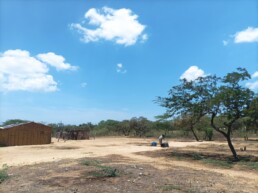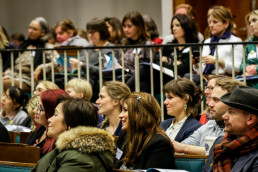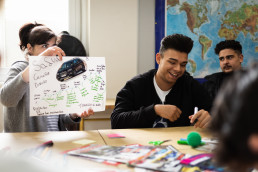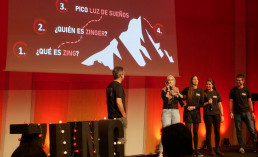Reflection on climate change and nutrition
REFLECTION ON CLIMATE CHANGE AND NUTRITION
Inés Azaiez, Programme Manager Nutrition, Global Development Area
“It is clear that decisions we are making every day—how we heat our homes, what we eat, how we move around, what we choose to purchase—are making our food less nutritious, and imperiling the health of other populations and future generations” (Sam Myers, principal scientist at the Harvard School).
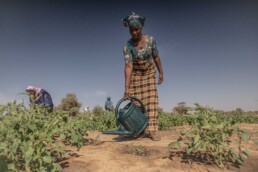
Climate change is one of the biggest challenges facing both our, and future, generations. The climate crisis is accelerating faster than previously anticipated, with various models predicting alarming to catastrophic impacts of the climate crisis on humans and the environment. In a world where undernutrition is declining very slowly and overnutrition is increasing rapidly, climate change will have multifaceted and severe effects on nutritional status and therefore survival, health and development outcomes. Climate change and nutrition have overlapping agendas and enhanced collaboration could generate a common agenda for both communities.
According to the FAO [1], it is estimated that between 691 and 783 million people in the world faced hunger in 2022 while more than 3.1 billion people in the world – or 42% – were unable to afford a healthy diet in 2021.
Currently, an estimated 148.1 million children under five years of age (22.3%) were stunted, 45 million (6.8%) were wasted, and 37 million (5.6%) were overweight.
The last report reports published by The Intergovernmental Panel on Climate Change [2] confirm that Human activities, principally through emissions of greenhouse gases, have unequivocally caused global warming, with global surface temperature reaching 1.1°C above 1850–1900 in 2011–2020. Global greenhouse gas emissions have continued to increase over 2010–2019, with unequal historical and ongoing contributions arising from unsustainable energy use, land use and land-use change, lifestyles and patterns of consumption and production across regions, between and within countries, and between individuals (high confidence).
Human-caused climate change is already affecting many weather and climate extremes in every region across the globe. This has led to widespread adverse impacts on food and water security, human health and on economies and society and related losses and damages to nature and people. Vulnerable communities who have historically contributed the least to current climate change are disproportionately affected.
Climate change and undernutrition
Climate change exacerbates undernutrition through three causal pathways related to (or though combined effects on) food security, care practices and health. Quantifying the effects of climate change on undernutrition is a complex exercise, due to the multiple causal pathways leading to undernutrition [3].
An increasingly large body of evidence indicates that undernutrition in all populations, particularly vulnerable populations (such as women, infants, children and adolescents), is likely to be magnified by climate change, without effective countermeasures. The impacts of climate variability and change on nutrition occur indirectly, by exacerbating existing threats to “food, care and health”. The mechanisms through which climate change jeopardizes “food, care and health”-related determinants of nutrition, are myriad. The arrows on the left in Figure 1 highlight that climate variability and change can also affect the entire food system at multiple levels (immediate, underlying and basic).

Figure 1: Conceptual framework: climate and nutrition security: WHO, 2021 [4].
The ramifications of climate change on nutritional outcomes in the future are estimated to be significant, and the exacerbation of current threats to food and nutritional security will only make it harder and more expensive to reduce undernutrition in the coming decades. Furthermore, undernutrition undermines the health and coping mechanisms of vulnerable populations, and lessens their capacities to be resilient and adapt to other consequences of climate change. The Fifth Assessment Report of the Intergovernmental Panel on Climate Change (IPCC) concludes with high confidence “that climate change will have a substantial negative impact on (i) per capita calorie availability; (ii) childhood undernutrition, particularly stunting; and (iii) undernutrition-related child deaths and DALYs (disability adjusted life years) lost in developing countries” [4].
Climate change worsens unsustainable food systems by affecting all aspects of food security: availability, access, utilisation and stability, through diverse impacts on crops, pests, diseases, weeds, pollination, forests, livestock, and aquatic food sources.
Food availability will be directly impacted by increased climate variability and long term climate change. Longer term warming, increased atmospheric carbon dioxide (CO2), and altered precipitation patterns will have wide sweeping impacts on agricultural production and livelihoods assets and increase irrigation water requirements.
This will increase heat and water stress in areas already under pressure, while increasing pests and diseases in crops and livestock, thus decreasing yields and changing the suitability of areas for food production. In southern Madagascar, four years of successive droughts have wiped out harvests and hampered access to food and the area is on the brink of experiencing the world’s first “climate change famine”, according to the UN [5].
The IPCC [6] has concluded that risks of foodborne and waterborne disease and vector-borne disease will increase, further impacting nutrition as a consequence of warmer temperatures, extreme weather, and shifting precipitation patterns. In 2019, unusual weather conditions exacerbated by climate change created conditions conducive to a desert locust outbreak which destroyed food and vegetation and jeopardised food security across Africa, the Middle East and South Asia. Recent evidence from Tanzania also identifies the association between reduced cereal (maize) yields and maternal malnutrition during pregnancy as key pathways linking heat shocks to agricultural production and subsequent child growth. Increased ocean acidification and other adverse changes to marine ecology will also affect households who rely on fish to support their livelihoods and nutrition. For example, one study has estimated a 92% reduction in coral reef habitats by 2100 due to ocean warming and acidification [7].
There is evidence that rising carbon dioxide levels from human activity may be reducing nutrient levels (protein, iron and zinc) in plant foods, particularly cereals and legumes.
These are all essential nutrients for people’s health and represent major risks to people’s health in developing nations where deficiencies in zinc, iron and protein lead to major burdens of disease. These diseases range from maternal mortality around childbirth to problems with cognitive development in children. Cereal crops are the main source of protein and micronutrients in many low-income countries.
Climate change is also one of the key drivers of biodiversity loss in agriculture, which in turn reduces the ability of the food system to respond to shocks and stresses, including further climate change.
Increased heat and water stress is also expected to increase the incidence of foodborne pathogens and mycotoxins during food storage, processing and transportation. There is a general lack of governance and policies around food safety, while the risks of food safety and increasing food waste in rural communities are especially acute as retail infrastructure and cold storage are often basic and access to water may be restricted. In addition, the various climate-related changes impacting food safety – including human, animal and vector behaviours, and changing pathogen, organism and pest survival, growth and transmission behaviours– are more likely to occur in countries where food monitoring and surveillance systems are less robust. Thus, poor detection of environmental and chemical contamination further increases the risk to public health and nutrition through the acute and chronic exposure to contaminants [8].
Access to food may reduce through climate change impacts increasing the price of food. A key determinant for access is the price of food which strongly reacts to fluctuations in global production following extreme climate-related events and longer-term reduced crop yields resulting from climate change. Resource-poor households commonly prioritize calorie-rich but nutrient-poor foods as an adaptation strategy to reduced food availability and increased food prices. In the long term, the recurrent and intense nature of such events can increasingly destabilize regional and local food systems, with a potential to trigger food crises, acute malnutrition, and even famines [4].
Furthermore according to ICCP, Climate change is contributing to humanitarian crises where climate hazards interact with high vulnerability (high confidence). Climate and weather extremes are increasingly driving displacement in all regions. Flood and drought-related acute food insecurity and malnutrition have increased in Africa and Central and South America. While non-climatic factors are the dominant drivers of existing intrastate violent conflicts, in some assessed regions extreme weather and climate events have had a small, adverse impact on their length, severity or frequency, but the statistical association is weak. Through displacement and involuntary migration from extreme weather and climate events, climate change has generated and perpetuated vulnerability [2].
Climate change, obesity and DR-NCDs
There is limited but emerging evidence that climate change will adversely affect the risk of overweight and obesity and, as a consequence, diet-related non-communicable diseases (DR-NCDs). While severe food insecurity and hunger are associated with lower obesity prevalence, mild to moderate food insecurity is paradoxically associated with higher obesity prevalence, particularly in contexts where high-energy, commercially processed foods are available at low cost. Increasing temperatures are associated with less physical activity in many parts of the world, particularly among urban populations, while price instability of fresh foods can reinforce dependency on highly processed foods, especially in the context of aggressive marketing. Climate change-induced migration, the majority of which is likely to be rural-urban migration, is predicted to become increasingly driven by food insecurity. Urbanisation has been associated with an increased risk of overweight and obesity through a combination of greater availability of energy dense, processed foods in combination with mass media marketing, and less leisure and work-related physical activity. Furthermore, in humanitarian settings, food assistance provided during an emergency response, such as to climate-induced natural disasters, can weaken long-term food and nutrition security; for example, low-quality, imported foods may persist in the local diet long after the humanitarian response has concluded.
It is likely that these and other pathways leading to climate change-induced food and nutrition insecurity will exacerbate already-changing dietary patterns, which tend to be increasingly comprised of high-energy and low-nutrient dense imported and processed foods [8].
The world’s poorest are paying the highest price
While climate change is global, impacts are local and regional, and vulnerability varies widely across communities, countries, and regions [9].
The injustice of climate change is that the people who are suffering the most—the world’s poorest—are also the ones who did the least to contribute to the problem.
In fact, recent data showed that the poorest people already suffering from the highest rates of undernutrition will be the most vulnerable to climate change (figure 2).
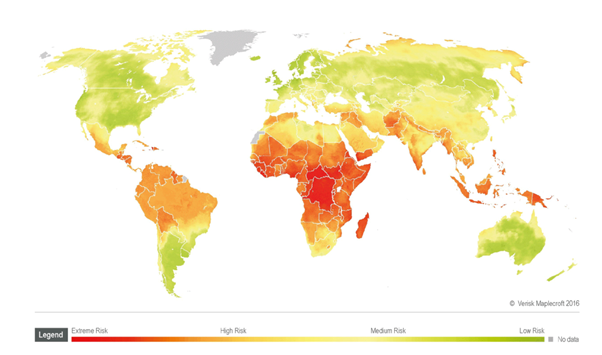
Figure 2 : Map of climate vulnerability. It shows the places that will be hit hardest by global warming, including extreme weather, drought, and sea level rise [10].
Vulnerability will increase with climate change: exposure to climate change-related effects and dependence on climate-sensitive resources will rise, as adaptive capacity decreases. They rely on small-scale rain-fed farming systems and agricultural labour as their main source of food and income, making them highly dependent on climate-sensitive natural resources. Climate change is increasingly and simultaneously eroding their livelihoods assets and access to natural resources and services, while at the same time eroding their capacity to cope with climate-related crises, and adopt sustainable solutions to climate change. The hungry poor, especially women and children, are already the main victims of the changing climat. Indeed, when facing a disaster, people have no choice but to resort to negative coping strategies (reduction of food intake, sale of productive assets etc.) that hinder their resilience, increase their vulnerability to climate threats, and exacerbate their food and nutritional security (figure3). Undernutrition undermines the ability and capacity of vulnerable populations to implement resilient climate coping strategies [11].
Conclusion & way forward
Climate change is affecting malnutrition rates around the world through multiple channels. In regions experiencing historic levels of drought, like the Horn of Africa, millions are suffering from near-famine. Elsewhere, climate change is increasing the incidence of diseases that contribute to malnutrition. Climate change can also diminish the nutritional value of crops, and climate change can affect families’ livelihoods, reducing their incomes and making nutritious foods less affordable.
As appointed by EU experts 14, To tackle the risk of severe and frequent climate related disasters, greater science – policy interface based on improved knowledge, stronger evidence and a greater focus on Disaster Risk Reduction and Climate Change Adaptation are essential.
Adaptation, in response to current climate change, is reducing climate risks and vulnerability mostly via adjustment of existing systems. Many adaptation options exist and are used to help manage projected climate change impacts, but their implementation depends upon the capacity and effectiveness of governance and decision-making processes.
Timely and well-designed adaptation actions have the possibility to avoid these dramatic issues by mitigating theimpacts of climate change on the most vulnerable through preparedness, risk reduction, both applied to the livelihoods and the organization of society.
Effective adaptation options, together with supportive public policies enhance food availability and stability and reduce climate risk for food systems while increasing their sustainability. Effective options include cultivar improvements, agroforestry, community-based adaptation, farm and landscape diversification, and urban agriculture. Institutional feasibility, adaptation limits of crops and cost effectiveness also influence the effectiveness of the adaptation options. Agroecological principles and practices, ecosystem-based management in fisheries and aquaculture, and other approaches that work with natural processes support food security, nutrition, health and well-being, livelihoods and biodiversity, sustainability and ecosystem services.
References:
[1] FAO, IFAD, UNICEF, WFP & WHO, 2023. The state of food security and nutrition in the world :Urbanization, agrifood systems transformation and healthy diets across the rural–urban continuum. https://www.fao.org/publications/home/fao-flagship-publications/the-state-of-food-security-and-nutrition-in-the-world
[2] IPCC, 2022. Climate Change 2022: Impacts, Adaptation and Vulnerability Working Group II Contribution to the Sixth Assessment Report of the Intergovernmental Panel on Climate Change
[3] Word Food Programme, 2021. Climate impacts on food security and nutrition. https://documents.wfp.org/stellent/groups/public/documents/communications/wfp258981.pdf
[4] World Health Organization, 2021. Technical series on adapting to Climate Sensitive Health Impacts – Undernutrition. https://www.who.int/publications/i/item/9789241515566
[5] BBC. (2021). Madagascar on the brink of climate change-induced famine. www.bbc.co.uk/news/world-africa-58303792
[6] IPCC. (2014). Climate change 2014: Impacts, adaptation, and vulnerability. Working Group II contribution to the fifth assessment report of the Intergovernmental Panel on Climate Change. New York; Cambridge University Press.
[7] Speers, A.E., Besedin, E.Y., Palardy, J.E., & Moore, C.,2016. Impacts of climate change and ocean acidification on coral reef fisheries: An integrated ecological-economic model. Ecological Economics, 128, 33–43.
[8] Emergency Nutrition Network, 2021 Nutrition and climate change: Current state of play: Scoping review. https://www.ennonline.net/nutritionandclimatechange
[9] Archibald, C.L., Butt, N. Using Google search data to inform global climate change adaptation policy. Climatic Change 150, 447–456 (2018). https://doi.org/10.1007/s10584-018-2289-9
[10] Williams J., 2018. Two maps: climate responsibility and climate vulnerability. https://earthbound.report/2018/06/28/two-maps-climate-responsibility-and-climate-vulnerability/
[11] ACF-INTERNATIONAL, 2014. Who cares about the impact of climate change on hunger and malnutrition? A plea to the international community to ensure food and nutrition security for the most vulnerable in a changing climate.
[12] European Union EU: https://joint-research-centre.ec.europa.eu/jrc-news-and-updates/inform-climate-change-risk-2022-01-12_en
ZING - Advancing the scalability of evaluation!
This year, the measurement of ZING’s impact indicators on employability makes an important leap in its professionalisation. With the incorporation of the personalised chatbot ORIEN, we have transformed the management of youth data collection from a slow, human resources intensive process with difficulties of accessibility to young people, to one that is:
- Fast and effective management
- Fully automated
- And with high accessibility thanks to the direct WhatsApp channel.

ORIEN has taken a further step towards innovation and professionalisation in the area of data collection to achieve impact indicators for job placement.
The chatbot, apart from providing guidance on insertion issues, transforms the management of data collection from young people through a fast, effective and fully automated management, thus systematising this task, which is sometimes complex due to the multiple variables to be taken into account.
How does it do it? Through the direct WhatsApp channel, which means high accessibility and optimisation of time and resources, which translates into a user experience that is highly valued by the entire group of participants.
It is clear to us that ORIEN has come a long way to stay and to set a trend in the sector, not only because of its content and its wide field of action, but also because of its great capacity to design a structure, to collect and manage data in an agile way, which allows us to provide value and rigour within the world of employability.
Call for social innovation projects in Senegal
The Nous Cims Foundation is launching a call to receive proposals of social innovation projects in Senegal. This call is only open to local, non-profit Senegalese organizations and entities, and to young social entrepreneurs of the country. The selected parties will receive expert backing from Nous Cims, to transform their ideas into projects of impact. The deadline for presenting proposals is 7 April 2020.
Since 2013, Nous Cims has been creating, developing and financing social transformation projects in Spain and in a dozen countries of Africa, Asia and Latin America, including Senegal. It is precisely in this country where the foundation opened its first local branch in Dakar.
In this first call in Senegal, Nous Cims is seeking projects that meet today’s challenges of the local community, in the fields of financial empowerment of women, professional training, the employability of young people and emotional well-being.
All projects presented will be thoroughly examined by the evaluation council. Selection criteria will, above all, value innovation, effective impact, durability and reproducibility of the proposals presented.
Once the first assessment has been made, the individuals and organizations, which have presented proposals that best suit the foundational goals of Nous Cims, will be invited to an exploratory meeting in Dakar in May. The projects that pass the final evaluation will have to be expanded. It is expected that the Nous Cims board of directors approve the projects and they will finally be developed in October 2020.
The Nous Cims Foundation is involved in the European Mentoring Summit 2020 of Barcelona
Barcelona will be the European capital of Social Mentoring. It is holding the European Mentoring Summit 2020, the major event for chief academics, professionals and expert entities in social mentoring in the world. The host will be the Coordinator of Social Mentoring, a benchmark entity at state level. The Summit will be sponsored by Nous Cims, which is also participating in the Philanthropic Track jury, where it will be represented by Miquel Antonijuan, director of the Employability Area and the Zing programme.

The 2020 Summit is the third biannual congress on social mentoring held in Europe. The event aims to connect people and projects from Europe and all over the world, which work in the field of mentoring, to establish connections and align academic research and practical experience.
The Summit has hence been conceived as a place where participants can explore new lines of action and research. Under the title “Mentoring for social inclusion”, the main topics of the 2020 edition are the association between academic and practical research, sociocultural diversity, mentoring with a gender perspective, and methods and ethics in the field of mentoring. Speakers will include internationally renowned experts. Academic and practical workshops will also be organized during the congress, along with various areas, designed for exchanging knowledge and tools.
One of the highlighted activities of the 2020 Summit is the Philanthropic Track. This is an area in which ten European entities will present their projects in social mentoring to companies and foundations, including Nous Cims. Economic recognition will be given to the best presentation.
The European Mentoring Summit 2020 is held at an excellent time for mentoring, which has increased exponentially throughout Europe, to become public policy in favour of the inclusion of vulnerable people. It is also an opportunity for the city of Barcelona to become a forerunner in promoting this method, aligned with the principles of equal opportunities and social cohesion, and be a benchmark in social mentoring in southern Europe.
Social entities can now register their young people for the Vocational Discovery Workshops of the Zing Programme
Zing Programme is starting up a new edition of the Purpose and Vocation Discovery Programme, which is targeted at young people who are disoriented or demotivated, linked to social entities, and who have decided to take the first step regarding their educational and/or professional future, and who also want to discover their potential and talents (soft skills). The workshops of this programme, which are completely free, will run between the months of January and April 2020, with the aim of providing the young people with tools and motivation when choosing which studies to pre-register for in the 2020-21 academic year.
The programme is open to young people from all of Spain, mainly between 16 and 21 years of age, although it is also possible to participate up to 30 years of age. Participants are invited to join the Zing Programme through their referring teachers. Interested social entities can express their interest and submit registrations via email at vocacio@nouscims.com.
An expedition by young people towards their personal, educational and professional summit
The “Discover your summit” workshops are motivational, inspiring, dynamic and experiential workshops in Spain with their own unique methodology, in which young people are the protagonists of their own lives and paths. Together with their group – the expedition – and accompanied by the workshop facilitator, the “Sherpa”, participants explore the pathway to reaching their educational and professional summit.
The workshops are divided into five sessions of 4 hours each (total of 20 hours), in which the participants work on two parts: one related to self-knowledge, the re-definition of beliefs and empowerment; and the second part that is oriented towards the vocation that is formulated in an action plan, which marks the path to follow, with excitement and enthusiasm. During the “base camp” and the five other camps through which the participants pass, the “Sherpas” provide innovative, creative and fun tools to help them choose the most appropriate pathway applying a personalized approach, given that the Zing Programme considers every young person to be unique.
According to Miquel Antonijuan, Director of the Zing Programme, “when a young person is motivated and commits to their educational pathway, the possibility of successfully completing their studies grows considerably”. Regarding the results of previous editions, after completing the workshops, 76% of the participants go on to study and 90% go on to study and/or work.
About Zing Programme
As of the 2019-20 academic year, nearly 1,000 students from Spain have benefited from the various annual calls for scholarships from the Nous Cims Private Foundation, an initiative that is united under a new concept this year: Zing Programme.
Zing gets its inspiration from Tenzing Norgay, the Sherpa who accompanied mountain climber Edmund Hilary to reach the summit of Everest for the first time in history. The Zing beneficiaries (boys and girls in a situation of vulnerability and referred by social entities, with the motivation and commitment to continue studying and educating themselves as professionals) follow a complete pathway, which includes the discovery of their vocation, applying for high-impact training scholarships in professional and university education, mentoring and individual support up to labour insertion. Once these young people have reached their summit, the Zing Programme proposes that, through a social return, they help other young people to also fulfil their educational and professional dreams.

The Nous Cims Foundation opens its first local satellite unit in Senegal
Since the end of 2019, Nous Cims has a satellite unit located in Dakar (Senegal) and a permanent professional in this country, Oumar Thiam. Having Thiam as the Nous Cims Project Manager in Senegal will significantly improve the quality of the foundation’s interaction with local partners. From Dakar, Oumar will also supervise the different phases of each of the projects that the Global Development Area of the foundation is implementing in the African country.
Oumar Thiam has acquired over 20 years of experience, with proven technical strengths, in the area of international cooperation while working from Senegal. Oumar has held positions of responsibility in various NGOs, embassies and international organizations. Regarding his education, Thiam earned a State Diploma (Diplôme d’État) from the National School of Applied Economics (École Nationale d’Économie Appliquée) in Senegal.
“We monitor and support local entities from the territory as a way to ensure close integration between Nous Cims and partners in Senegal” explains Thiam.
Regarding the objectives of the Nous Cims satellite unit, “being present in the territory will allow us to better identify the challenges we take on, to conduct a more precise search for the local partners with whom we collaborate, and to set up quality projects”, the Nous Cims Project Manager in Senegal tells us. “We’ll be able to more easily share the lessons learned and, in turn, innovate with the local community”, Thiam adds.
The Nous Cims satellite unit in Dakar is located in a space provided by the Secretariat of the Écoles Pies de l'Afrique de l'Ouest, in the Dieuppeul district. Under the management of David Gervilla, Director of the Global Development Area of Nous Cims, Thiam will manage projects such as the University Scholarships Programme of Écoles Pies or the Women Entrepreneurship and Leadership Project against Malnutrition of Action against Hunger.
How does Nous Cims work on international cooperation?
The strategy of the Global Development Area of the Nous Cims Foundation is mainly based on identifying local partners who are notable for their professionalism, commitment, innovative spirit and the impact they generate in their communities. Together with these partners, joint projects are developed in the areas of economic, educational, health and psycho-social development.
Currently, Nous Cims is developing projects in Colombia, Honduras, Central America, Ethiopia, Jordan, Palestine and the Middle East, as well as Senegal. The foundation is permanently open to receiving proposals and establishing a dialogue with people and global and local entities that would like to foster or are already working on projects in its areas of work.
Nous Cims and Kalida foster Art Therapy workshops at the hospitals of Terrassa, Mataró and Manresa
Patients who are in the oncological process and undergoing active treatment in the Oncology services of Mataró Hospital, Terrassa Hospital and Althaia Hospital of Manresa, can benefit from Art Therapy in some new weekly workshops.
This initiative is being fostered by Nous Cims in cooperation with the Kalida Foundation, following the line of promoting projects that have positive effects on people living with cancer, as well as on their relatives and care givers.
The project referred to is called Art Therapy: we’re any colour. According to Marta Mosquera, the Director of the Emotional Well-being Area of Nous Cims, the initiative was christened with this name after “thinking about the different experiences that people in the disease process go through, including support during the greyest moments of cancer and, humbly, in the colourful spaces and settings that can appear”.
The sessions follow a structured process, first of all, by initial contact, in which the participants' concerns are resolved. Then a relaxation and introspection activity takes place. Subsequently, art is produced, whether plastic arts (painting, drawing, sculpture, photography, collage, etc.), written expression (poetry and/or narrative) or music, self-expression through movement, theatre and others.
The last part of the session is dedicated to reflection: participant share their experiences, putting them into words, talking with the art therapists and finding new meanings for the emotions they’ve felt. The final objective of these sessions is for these people to find greater well-being, improve their mood and decrease their level of fatigue, anxiety and stress.
Multi-centre study on Art Therapy
The Althaia Hospital of Manresa, the Mataró Hospital and the Terrassa Hospital join the Nous Cims and Kalida project with a view to conducting a multi-centre study to assess the impact of art therapy on the lives of persons with cancer.
Specifically, the support provided through art therapy is based on an actual involvement in art, which helps people to very quickly and profoundly come into contact with their inner world. It is a therapy that is empirically proven to aid medical treatments.
To be precise, this therapy opens up a symbolic way to talk about all the concerns and fears that any person may have during a cancer process. In fact, cancer is considered to be a high-impact event in the lives of people, and leads to the appearance of fear and uncertainty, among other emotions. These emotions can all be embodied through artistic works, and sharing them with a group and receiving the support of art therapists helps provide another way to manage experiences.
The Nous Cims grant programme passes the baton to the Zing Programme
Nous Cims, at its annual meeting of grant holders, presented the new Zing Programme, a project arising from the foundation’s grant programme, whose objective is to transform the lives of the young participants by facilitating their access to educational pathways. The new Zing Programme brings together all the talent and vocational activation methodology, impact training and individual support for these youths under a single initiative created by the Employability Area of the Nous Cims Foundation.
From 2013 up to the 2018/19 academic year, a total of 758 students – youths who were referred by social entities and were in a situation of economic or social vulnerability – benefited from the various annual calls to apply for Nous Cims grants.
The Zing Programme starts its journey by expanding the scope of the initiative, consequently benefiting 600 young people of Catalonia and Spain in this 2019/20 academic year. They are all sufficiently motivated and are highly committed to continuing with their studies and receiving training as professionals.
Why the Zing Programme?
The Zing concept gets its name from and is inspired by Tenzing Norgay, the sherpa who accompanied mountain climber Edmund Hilary to reach the summit of Everest for the first time in history.
According to Miquel Antonijuan, the director of both the programme and the Employability Area of Nous Cims: “once these young people have reached their summit, we’d like them to stay with us. Through social return, we want them to help other boys and girls in the same process, so that they can also fulfil their educational and professional dreams”.
All participants in the Zing Programme follow a training pathway. This includes discovering their vocation (Zing Vocation) and a call to apply for high-impact educational grants for vocational training and university education, in addition to individual support until labour insertion. A pilot project for students from secondary schools, called Zing High Schools, is also being tested, which includes mentoring as one of the cornerstones of the programme.
The first Zingday, at the CCIB
The majority of young people who have become ‘zingers’ during this academic year, meaning beneficiaries of the programme and members of the Zing Network, participated in the first Zingday. Specifically, over 100 social entities from Catalonia and Spain, together with schools, high schools and other key players in the social sector, are working to turn the Zing Programme into a solid, high-impact model, one of empowerment for young people.
Zingday benefited from the special collaboration of the Barcelona International Convention Centre, which offered it the use of the CCIB Forum Auditorium in order to make this encounter a reality.
Zing starts the year with a new challenge: the Zing High Schools pilot project begins, including its mentoring programme
A total of 36 students from eight high schools of the Barcelona Metropolitan Area will participate in the Zing High Schools pilot project. It is a spin-off of Zing Programme, a talent activation, impact training and youth support programme created and developed by the Employability Area of the Nous Cims Foundation.
Zing High Schools arose after having verified that the economic and social problem in many secondary schools is as complex, or more so, as that encountered by social entities that work side by side with the Nous Cims team on the Zing program.
The participants in Zing High Schools are ex-students of the 4th year of mandatory secondary education put forward by their high schools due to their motivation and commitment to their studies. They have all begun an intermediate level vocational training programme for the 2019-2020 school year, will participate in the Zing Vocational Orientation Programme, and will be able to study what they really want to, without their economic situation impeding them.
Moreover, thanks to the collaboration of the Social Mentoring Coordinator and the social volunteering entity, AFEV, the students will receive individual support from the mentor in their municipality so that they can adjust their expectations with regards to the Zing programme and make decisions about their academic and professional future.
Introductory mentoring workshop
In order to dispel any false beliefs that young people might have about mentoring, Nous Cims organized an introductory workshop based on theatrical improvisation as the starting point, performed by actors from Improshow.
Close to thirty young people from Barcelona, Terrassa, Sabadell, Vilanova i la Geltrú, Badalona and Sant Vicenç dels Horts enjoyed a different, dynamic and creative experience during the workshop, based upon which they’ll be able to start building a positive relationship with their mentor in the upcoming months.
The pilot test of the Komtü programme begins at the El Turó school in Montcada (Barcelona)
The El Turó Pre-school and Primary Education centre of Montcada i Reixac (Barcelona) has been selected because of its educational programme to activate the pilot project of the Komtü programme. It is a new emotional support programme for boys and girls between 3 and 12 years of age, created and developed by the team of the Emotional Well-being Area of the Nous Cims Foundation.
The programme, which will be tested at the El Turó school in Montcada, is notable for its innovation in the area of emotional and relationship well-being at school.
Specifically, Komtü is inspired by scientific studies that indicate that relationship experiences leave an emotional footprint that can condition the personality and attitude of children throughout their entire lives. “A good experience can entail better learning and a greater capacity for self-awareness, empathy and the acceptance of differences”, according to Carles Bosch, psychologist and expert in the programme.
The entire educational community of El Turó will be involved for three years in the pilot test of the Komtü programme, which is adapted to the reality of each school. The programme’s technical team, which will work full-time at the school three days per week, will provide training on emotional support to not only the executive team but also to the teaching staff and non-teaching personnel at the school.
More information in the local weekly paper, La Veu de Montcada.
